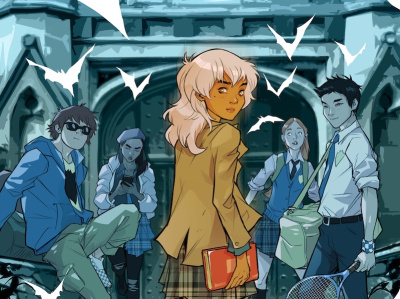
Do you think American or Korean sourced material will ever hit the top of the best-seller lists?
Not only could, but will. Whether it happens this year, next year, the year after that is totally open to debate but the fact of the matter is manga is evolving. The way it's evolving is already being accepted and embraced by people shopping in the manga section. It's only matter of time until, whether it's some kid in Barcelona or some kid in Topeka, Kansas, comes up with a story which so viscerally grabs the category that it will be a number one hit. I'm more convinced of this then I was a couple years ago when we first began dabbling in material from other countries. It'll absolutely happen.
You've been experimenting recently with frequency and so have other publishers. In particular, you've been running Fruits Basket monthly at times. What result have you seen from that experimentation and under what circumstances will you put out titles under that more aggressive frequency in the future? Do you base it on sales potential, the season, the length of the series, some other factors?
It probably has the most to do with the season. Late spring and the summertime season are really huge in this business because of kids getting out of school. As to when and if we would do it in the future, obviously it's been wildly successful in a lot of ways this year. You try not to generalize too much from a phenomenon like Fruits Basket because it's so unusual and it writes its own rules.
I think we'll always have some seasonality to the business and we'll be willing to do that. In general our philosophy has been to release very gradually. I don't know if anybody's really noticed it yet. We want to release slightly fewer books at a slightly more leisurely pace. That appears to be what retail wants, that appears to be a little bit more consumer friendly, to not jam so many things out in any given month, in any one series so quickly. That's the general arc that our release strategy takes, but there will continue to be periodic seasonal exceptions particularly with hot-selling titles. So we could very well do a certain amount of that in the future.
So you feel it was successful.
Yes, very successful.
How many new titles are you doing a month now and how do you see that changing in the coming year?
Our product line is so diverse...we tend to look at manga as manga whether it's licensed or original. '06 looks to be in the 32 to 34 range. Then there are the novels and Cine-manga, in addition to that. As I mentioned before, we think over time that it's probably in our best interest based on what's happening in the category to gradually rein that in a bit. That's already started to happen. We've had some months in the past couple of years that were beginning to approach the forty level. You'll see a very gradual adjustment there.
How many Cine-manga titles are you doing a month and what trend do you see in those?
It really varies because Cine-manga is so opportunistic in terms of pop culture phenomena. Next year we're looking at maybe two to four products a month, something in that neighborhood.
The things you described as characteristics of manga, does Cine-manga fit that definition?
It's certainly a challenge. With Cine-manga it's more of a physical presentation issue, the way the pages are laid out in panel format, that's where at least the superficial level of comparison to manga occurs. Because it borrows so much of its storytelling from original source material, whether TV or movie, it's fairly difficult to make the argument that the content of Cine-manga inside any given panel really adheres to any commonly accepted definition of manga. Cine-manga was developed for a mass audience. It was designed with an esthetic that caused it to sit on the page and look kind of like a manga. That's about as far as you could comfortably go in terms of its similarity to manga.
How much potential do you think there is for the continued growth of manga in America?
It's a really tough question. There's no getting around the fact that the growth of manga, while it's been stratospheric over the last few years, is definitely coming back to earth a bit. So we may be at a plateau where the consumers are trying to digest new product and an increased amount of product. I still feel in my bones that manga has the potential to attract a lot of people that are not currently manga readers. How that happens exactly, how much it costs to reach those new readers is unknown.
Given the excitement we see internationally about manga as an art form, given the absolute passion a lot of our original initiatives have engendered, given the network of creators that are committed to making this their life's work, the future of manga looks incredibly bright. Is it three times its current size? Is it six times its current size? That varies so considerably from territory to territory, I guess I would just say in a horribly non-specific way that manga is much more at the beginning of its life cycle than at its maturity. There's just so much more opportunity
You talk about a slowing growth rate. You also use the word plateau. There is still growth this year, isn't there?
Absolutely. Plateau's probably not an accurate word. That does connote a lack of growth. It's more of a deceleration of the pace of growth.
A channel question. How do you see the channel mix evolving? Specifically, what different roles do you see the two main channels, specialty retail channels versus the comic stores, playing in the future of manga?







